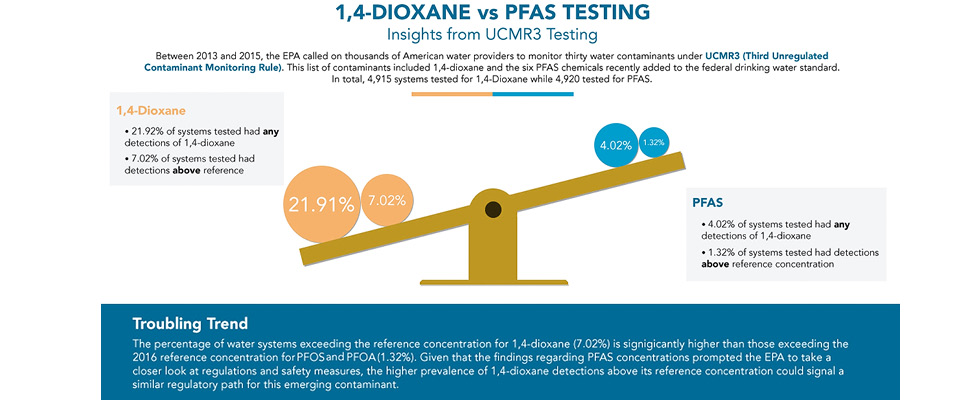
Computer hardware collects dust, builds heat and can eventually catch on fire or melt if it is not occasionally cleaned by air dusters. However, there is more than air inside air duster cans. Cleaning electronics requires chemicals, much like dry cleaning, that can be harmful to human health. To contain the reactivity of this air duster chemical cocktail that would otherwise dissolve its aluminum container, manufacturers rely on stabilizing solvents like 1,4-dioxane.
The journey of 1,4-dioxane from manufacturing wonder child to discarded environmental pollutant is paved with many paths. Its unique chemical properties, combined with decades of inadequate disposal practices, have allowed it to infiltrate the groundwater people rely on for drinking water and industrial processes. The omnipresence of 1,4-dioxane in detergents, shampoos, air dusters and countless other household products puts people in direct contact with the chemical and leaves them little choice but to wash it down the drain or throw it in the trash, transporting 1,4-dioxane to local wastewater treatment facilities, landfills and bodies of water.

Initial Findings
The contamination of groundwater and surface water in the United States from 1,4-dioxane is extensive. Between 2013 and 2015, the Environmental Protection Agency (EPA) called on thousands of American water providers to monitor thirty water contaminants under the Third Unregulated Contaminant Monitoring Rule (UCMR3). This list of contaminants included 1,4-dioxane and the six per- and polyfluoroalkyl substance (PFAS) chemicals recently added to the federal drinking water standard.
Among the 4,915 public water systems tested for 1,4-dioxane, 1,077 systems (21.91%) detected it in their water and 345 systems (7.02%) reported concentrations above the EPA’s reference concentration of 0.35 parts per billion (ppb), the threshold considered hazardous to human health. The highest 1,4-dioxane detection was 34 ppb.
As a comparison, that same study found 198 systems out of 4,920 participating water systems (4.02%) detected PFAS, with 65 total systems (1.32%) reporting perfluorooctane sulfonate (PFOS) and perfluorooctanoic acid (PFOA) levels above the 2016 reference concentration of 70 parts per trillion. Considering that the PFAS findings prompted the EPA to set regulations and safety measures for PFAS, the higher prevalence of 1,4-dioxane detections and its health risks could signal a similar need for regulatory action.
Health Impacts
Of particular concern is 1,4-dioxane’s classification as a likely human carcinogen. The EPA’s 2023 supplemental risk evaluation of 1,4-dioxane explained that the chemical had “cancer risk estimates higher than one in one million, including to communities associated with drinking water sourced downstream of release sites.”
Beyond cancer risks, research has shown that 1,4-dioxane can adversely affect the liver, kidneys and central nervous system. Additionally, 1,4-dioxane exposure can pose more severe risks during pregnancy, to infants and to individuals with compromised immune systems.
Public awareness of toxic chemicals in drinking water is at an all-time high. This concern for public health is leading some state regulators to act on 1,4-dioxane ahead of a federal decision.
States Leading the Way
Several states have established or are considering notification, cleanup and health-based 1,4-dioxane standards.
New York became the first state to set a 1,4-dioxane drinking water maximum contaminant level (MCL) of one ppb in 2020. In addition to its water regulation, New York banned the sale of cosmetics, household cleaning products and personal care products containing 1,4-dioxane to reduce human contact and prevent the chemical from entering landfills and wastewater streams. Similarly:
- New Jersey started the process of establishing a drinking water MCL of 0.33 ppb in 2021.
- California has established a notification level of one ppb and a response level of 35 ppb.
- Virginia and Illinois have passed legislation requiring their health boards to develop an MCL.
These state-level regulations show a growing awareness of 1,4-dioxane’s potential health risks and point in the direction of possible regulatory action in more states and at the national level. Considering the precedent set by emerging contaminants like PFAS, the regulatory landscape could soon evolve as scientific evidence and public concern catch up. For water utilities, taking proactive steps to prepare for potential regulations can work to their advantage. However, the cost of remediation, public relations and labor may daunt even the most prepared.
Pump & Treat
Although public water agencies and private companies are typically not responsible for the contamination of their water sources, they may be saddled with the cost and responsibility of detecting, cleaning and monitoring efforts.
Since 1,4-dioxane resides in aquifers, pump-and-treat remediation is the primary treatment method used today. Pump-and-treat remediation pumps groundwater to the surface, treats 1,4-dioxane and then discharges the treated water into surface water or reinjects it into the groundwater. This treatment method aims to make groundwater safer for later use and prevents the migration of fast-moving 1,4-dioxane plumes to neighboring communities.
Water treatment technologies like advanced oxidation processes (AOPs) and in-situ chemical oxidation (ISCO) have been determined to be the most effective 1,4-dioxane remediation solutions available. Unfortunately, both traditional water treatment methods and those used to address PFAS cannot effectively treat this contaminant. While it is fortunate that viable 1,4-dioxane treatments are available at a commercial scale and are being used by affected communities in Michigan, New Jersey and New York, they come with a hefty price tag. Utilities must pay for, operate and maintain the pumps and chosen remediation solutions indefinitely, raising their operating costs.
New Jersey at the Forefront
Certain states are likely to be more affected than others. For example, 1,4-dioxane was detected in 24% of the samples taken by New Jersey drinking water systems, compared to 11.4% nationwide.
New Jersey American Water detected concentrations over 100 times New Jersey’s expected 0.33 ppb MCL while sampling the Delaware River. Because the river provides drinking water to over 13 million people along the East Coast, utility officials were determined to find and eliminate the contaminant source. Through an extensive investigation, the water provider traced the 1,4-dioxane source to a plastics and polymer manufacturer that sent its wastewater to a municipal treatment plant. After being informed, the wastewater treatment facility immediately stopped accepting the manufacturer’s wastewater, helping reduce the 1,4-dioxane concentration in the Delaware River and improving drinking water quality for millions.
In 2022, New Jersey American Water invested $2.5 million in its Delaware River Regional Water Treatment Plant to further reduce 1,4-dioxane levels in its drinking water. The upgrades included installing advanced oxidation processes. To recover the costs of the upgrades, a lawsuit against Dow Chemical, Ferro and Vulcan Materials is underway to hold these companies accountable for 1,4-dioxane contamination instead of New Jersey water utilities and their ratepayers.
How to Prepare
As noted earlier, UCMR3’s findings showed that 1,4-dioxane was found in roughly 22% of the water systems that tested for it. Future state and federal water regulations have the potential to draw attention to thousands of water providers nationwide. If an organization discovers 1,4-dioxane or is operating in a state with emerging regulations, there are best practices to take to understand risks, plan and seek funding.
1. Assess the risks to the water supply. If a water system detects 1,4-dioxane or is near an area where 1,4-dioxane is detected, immediately try to understand the contamination’s scope and impact. Then, identify the community’s at-risk populations and prioritize their safety during planning.
2. Prepare a 1,4-dioxane action plan to manage public perception and communicate the health risks the chemical poses to drinking water.
Examples include:
- Continuously monitoring 1,4-dioxane sources to build a dataset
- Identifying contamination sources with local industry and regulatory agencies
- Devising a public communication strategy
- Considering treatment solutions
- Identifying funding strategies to cover the costs caused by the contamination
3. Budget for 1,4-dioxane treatment technology. Consider the long-term operational costs of monitoring and treatment, then seek funding. There are several federal and state grant and loan programs to help water providers fund engineering, equipment procurement and construction costs related to water infrastructure, such as state revolving funds.
Funding Options
Unfortunately, grants and loans rarely cover the full cost of public works projects, which is why increasing water rates is the most common way for water utilities to raise money. While a rate hike may be necessary, it often comes with drawbacks like ratepayer backlash, negative perceptions of the utility and the bureaucratic effort required to raise rates. Finding funding from other sources can be an advisable strategy, as it limits the financial burden on the utility and its ratepayers.
To cover the costs of water remediation, many utilities have sought litigation against the polluting manufacturers as a funding strategy, effectively holding the polluters accountable for the cleanup costs. Over the past few decades, a significant number of water utilities have successfully secured funding to address their contamination cleanups for a variety of contaminants, such as 3M’s recent $10.3-12.5 billion PFAS settlement.
The presence of 1,4-dioxane poses a potentially large disruption for water utilities. Its prevalence, along with its carcinogenic properties, stands to cost communities and the industry large sums of capital and operations expenses to remove it from drinking water sources and protect public health. If a utility finds itself impacted by 1,4-dioxane, preparedness, collaboration and creative funding can help the organization finance its needs and streamline the path to compliance.

